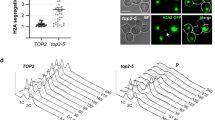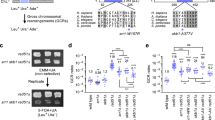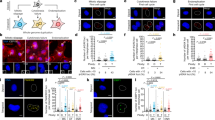Abstract
Gross chromosome rearrangements (GCRs), such as translocations, deletion of a chromosome arm, interstitial deletions and inversions, are often observed in cancer cells1,2,3. Spontaneous GCRs are rare in Saccharomyces cerevisiae; however, the existence of mutator mutants with increased genome instability suggests that GCRs are actively suppressed4,5. Here we show by genetic analysis that these genome rearrangements probably result from DNA replication errors and are suppressed by at least three interacting pathways or groups of proteins: S-phase checkpoint functions5, recombination proteins4 and proteins that prevent de novo addition of telomeres at double-strand breaks (DSBs). Mutations that inactivate these pathways cause high rates of GCRs and show synergistic interactions, indicating that the pathways that suppress GCRs all compete for the same DNA substrates.
This is a preview of subscription content, access via your institution
Access options
Subscribe to this journal
Receive 51 print issues and online access
$199.00 per year
only $3.90 per issue
Buy this article
- Purchase on SpringerLink
- Instant access to full article PDF
Prices may be subject to local taxes which are calculated during checkout

Similar content being viewed by others
References
Mitelman, F. Catalog of Chromosome Aberration in Cancer (Wiley Liss, New York, 1991).
Lengauer, C., Kinzler, K. W. & Voelstein, B. Genetic instabilities in human cancers. Nature 396, 643–649 (1998).
Padilla-Nash, H. M. et al. Molecular cytogenetic analysis of the bladder carcinoma cell line BK-10 by spectral karyotyping. Genes Chromosom. Cancer 25, 53–59 (1999).
Chen, C. & Kolodner, R. D. Gross chromosomal rearrangements in Saccharomyces cerevisiae replication and recombination defective mutants. Nature Genet. 23, 81–85 (1999).
Myung, K., Datta, A. & Kolodner, R. D. Suppression of spontaneous chromosomal rearrangements by the S-phase checkpoint in Saccharomyces cerevisiae. Cell 104, 397–408 (2001).
Lundblad, V. DNA ends: maintenance of chromosome termini versus repair of double strand breaks. Mut. Res. 451, 227–240 (2000).
Bryan, T. M. & Cech, T. R. Telomerase and the maintenance of chromosome ends. Curr. Opin. Cell Biol. 11, 318–324 (1999).
Grandin, N., Reed, S. I. & Charbonneau, M. Stn1, a new Saccharomyces cerevisiae protein, is implicated in telomere size regulation in association with Cdc13. Genes Dev. 11, 512–527 (1997).
Lahaye, A., Stahl, H., Thines-Sempoux, D. & Foury, F. PIF1: a DNA helicase in yeast mitochondria. EMBO J. 10, 997–1007 (1991).
Schulz, V. & Zakian, V. A. The Saccharomyces PIF1 DNA helicase inhibits telomere elongation and de novo telomere formation. Cell 76, 145–155 (1994).
Zhou, J.-Q., Monson, E. K., Teng, S.-C., Schulz, V. P. & Zakian, V. A. Pif1p helicase, a catalytic inhibitor of telomerase in yeast. Science 289, 771–774 (2000).
Diede, S. J. & Gottschling, D. E. Telomerase-mediated telomere addition in vivo requires DNA primase and DNA polymerases α and δ. Cell 99, 723–733 (1999).
Chen, C., Umezu, K. & Kolodner, R. D. Chromosomal rearrangements occur in S. cerevisiae rfa1 mutator mutants due to mutagenic lesions processed by double-strand-break repair. Mol. Cell 2, 9–22 (1998).
Lee, S. E., Paques, F., Sylvan, J. & Haber, J. E. Role of yeast SIR genes and mating type in directing DNA double-strand breaks to homologous and non-homologous repair paths. Curr. Biol. 9, 767–770 (1999).
Pennock, E., Buckley, K. & Lundblad, V. Cdc13 delivers separate complexes to the telomere for end protection and replication. Cell 104, 387–396 (2001).
Haber, J. E. Exploring the pathways of homologous recombination. Curr. Opin. Cell Biol. 4, 401–412 (1992).
Lewis, L. K. & Resnick, M. A. Tying up loose ends: nonhomologous end-joining in Saccharomyces cerevisiae. Mut. Res. 451, 71–89 (2000).
Lee, S. E. et al. Saccharomyces Ku70, Mre11/Rad50, and RPA proteins regulate adaptation to G2/M arrest after DNA damage. Cell 94, 399–409 (1998).
Signon, L., Malkova, A., Naylor, M. L., Klein, H. & Haber, J. E. Genetic requirements for RAD51- and RAD54-independent break-induced replication repair of a chromosomal double-strand break. Mol. Cell. Biol. 21, 2048–2056 (2001).
Bai, Y. & Symington, L. S. A Rad52 homolog is required for RAD51-independent mitotic recombination in Saccharomyces cerevisiae. Genes Dev. 10, 2025–2037 (1996).
Chen, Q., Ijpma, A. & Greider, C. W. Two survivor pathways that allow growth in the absence of telomerase are generated by distinct telomere recombination events. Mol. Cell. Biol. 21, 1819–1827 (2001).
Teo, S. H. & Jackson, S. P. Identification of Saccharomyces cerevisiae DNA ligase IV: involvement in DNA double-strand break-repair. EMBO J. 16, 4788–4795 (1997).
Herrmann, G., Lindahl, T. & Schar, P. Saccharomyces cerevisiae LIF1: a function involved in DNA double-strand break repair related to mammalian XRCC4. EMBO J. 17, 4188–4198 (1998).
Moore, J. K. & Haber, J. E. Cell cycle and genetic requirements of two pathways of nonhomologous end-joining repair of double-strand breaks in Saccharomyces cerevisiae. Mol. Cell Biol. 16, 2164–2173 (1996).
Boulton, S. J. & Jackson, S. P. Saccharomyces cerevisiae Ku70 potentiates illegitimate DNA double-strand break repair and serves as a barrier to error-prone DNA repair pathways. EMBO J. 15, 5093–5103 (1996).
Michel, B. Replication fork arrest and DNA recombination. Trends Biochem. Sci. 25, 173–178 (2000).
Vessey, C. J., Norbury, C. J. & Hickson, I. D. Genetic disorders associated with cancer predisposition and genomic instability. Prog. Nucleic Acid Res. Mol. Biol. 63, 189–221 (1999).
Petrini, J. H. J. The Mre11 complex and ATM: collaborating to navigate S phase. Curr. Opin. Cell Biol. 12, 293–296 (2000).
Khanna, K. K. & Jackson, S. P. DNA double-strand breaks: signaling, repair and the cancer connection. Nature Genet. 27, 247–254 (2001).
Nugent, C. I., Hughes, T. R., Lue, N. F. & Lundblad, V. Cdc13p: A single-strand telomeric DNA-binding protein with a dual role in yeast telomere maintenance. Science 274, 249–252 (1996).
Acknowledgements
We would like to thank V. Zakian, S. Lee, J. Haber, V. Lundblad, L. Symington and M. Charbonneau for plasmids and helpful discussions; P. Lau and K. Schmidt for comments on the manuscript; and J. Weger and J. Green for DNA sequencing. This work was supported by a NIH grant to R.D.K. and a Damon Runyon-Walter Winchell Foundation Postdoctoral Fellowship to K.M.
Author information
Authors and Affiliations
Corresponding author
Rights and permissions
About this article
Cite this article
Myung, K., Chen, C. & Kolodner, R. Multiple pathways cooperate in the suppression of genome instability in Saccharomyces cerevisiae. Nature 411, 1073–1076 (2001). https://doi.org/10.1038/35082608
Received:
Accepted:
Issue Date:
DOI: https://doi.org/10.1038/35082608
This article is cited by
-
Multi-step control of homologous recombination via Mec1/ATR suppresses chromosomal rearrangements
The EMBO Journal (2024)
-
Double-strand breaks induce inverted duplication chromosome rearrangements by a DNA polymerase δ-dependent mechanism
Nature Communications (2023)
-
Signification and Application of Mutator and Antimutator Phenotype-Induced Genetic Variations in Evolutionary Adaptation and Cancer Therapeutics
Journal of Microbiology (2023)
-
Telomerase subunit Est2 marks internal sites that are prone to accumulate DNA damage
BMC Biology (2021)
-
DNA damage response of major fungal pathogen Candida glabrata offers clues to explain its genetic diversity
Current Genetics (2021)



